-
The Vine that is Eating the Chair

The flowers dangle in the breeze, always watching…. A curiosity plant in my garden is Dutchman’s Pipe (Aristolochia trilobata), also unpoetically called birthwort. The flowers aren’t actually pretty. The politest description of them is that they resemble a large pipe. The flowers dangle in the breeze from the vine, which is evergreen with glossy leaves. It doesn’t produce a fruit.

Kind of like a pipe; kind of like a nose. Dutchman’s Pipe is an ornamental, fast-growing vine that can grow 20 -30 feet in all directions. Including up. Up and up. Onto the second floor balcony. And around everything in its path.

Climbing two stories and beyond. In other words, the vine is eating my balcony and my patio furniture.

I’m glad I wasn’t asleep in it! Dutchman’s Pipe emits weak unpleasant odor when disturbed; otherwise the flowers don’t have a scent. It grows so quickly that the idea of pruning it down is daunting but must be done (… what is that tapping sound I hear on the sliding glass door right now?). It twists and winds around and up the posts to the roof (… hmm… are the cats in the attic again? I’ve never heard them make thatnoise). Soon it will probably be over the roof, and I’ll have an unmanagable amount of vines to clip and haul to the compost heap (… excuse me, someone is at the door. “Hello? Who’s there? Hello?”). I’ve been putting the job off, but today seems like a good day to….. (“What the heck is…. nooo!!…

NOMNOM -
Melting Birds
Perhaps you’ve noticed birds doing strange things. I certainly have. Often they glance around afterwards to see if anyone is watching. One very silly-looking thing birds do is sun themselves. They will spread their wings to catch the most warmth, then go into kind of a trance.

Western Bluebird They’ll put their heads to the side and simply melt in the sun. Often I’ve wondered about the safety of their balance.

High wire act But they always seem to come out of it okay. I’ve seen many different kinds of birds melting in the warmth, taking a sun bath. Usually it makes me want to do the same.

Western Bluebird against heat-reflecting fence. -
What I Punch Now
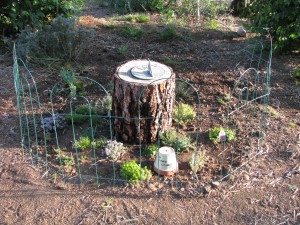
Sundial on the stump Its a Thyme Clock. So clever of me, I can hardly stand it. There is a sundial that I picked up at a thrift store, which sits on a stump. Around it are planted fourteen kinds of thyme! A Thyme Clock! I don’t have to punch a time clock at work… I can ‘punch’ (theoretically speaking that is) a Thyme Clock in my yard! (Or is the concept of a time clock too lost in history?). Ha!!!!
Sorry. Too much time in the sun (or should I say Thyme in the sun!) preparing for the Garden Tour tomorrow. I’m thinking its bedtime. Or bedthyme!!! No, it won’t stop anythyme soon. But it must, somethyme.
Sorry again.
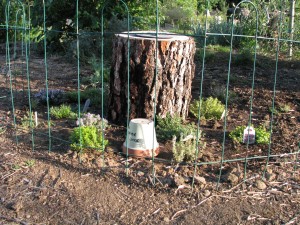
The Thyme Clock - Gardening adventures, Humor, Permaculture and Edible Forest Gardening Adventures, Rain Catching, Soil
Seven Hundred Gallons of Cooties

That's a lot of tea. One of the amazing and useful things I learned in my Permaculture Design Course was how to brew microbes in a bucket. Yes, I know, most women like champagne and jewelry. I like compost and worms. Whatever. Microbes are the microscopic creatures that make dirt into soil. By brewing a microbial tea you can so supersaturate the water with microbes that giving your plants just a small drink of it will greatly improve their health. That is because microbes eat plant litter and other decaying things and make available (and by ‘make available’ I mean ‘poop out’.) (Sorry.) more of the nutrients such as minerals that can be locked in the soil. Adding microbes to poor soil is a good thing.

Fish tank water, paint strainer and aerator: tools for microbial brewing. To make a microbial brew, you put good compost in a mesh bag such as a paint strainer or layers of cheesecloth. Obtaining compost from various sources gives you a good mix of microbes because not all the same microbes live in all soils. Suspend this bag in a five-gallon bucket of water, add a little organic molasses for the microbes to eat (like sugar to yeast), and if you want other soil additives such as rock sulphate, blood or bone meal, etc. I used water from my fish tank. Then you oxygenate the water with a fish tank aerator. After thirteen hours the microbes will have reproduced to a maximum capacity and the brewing is finished. You should use the brew within a few hours.

I'm not sure what made it foam, but it looked more like a brew. So, I did this a couple of times last Fall. Meanwhile, Jacob, who still maintains the Aquascape projects and volunteers some time here, managed to have donated to me a 700-gallon tank. It had been used for organic fertilizer.

The tank. The target: under the balcony. Jacob brought it over in his pick-up, and with the building of an impromptu scaffold he, my daughter and I (but mostly him) rolled it into place by my garage without damaging the propane tank or each other. Then he re-routed a rain gutter from my paltry 50-gallon rain barrel into the 700-gallon tank.

Trying not to crush the propane tank. The tank filled after a few rains, and I used most of the water recently between rains. Then the last two rains filled it to the top. Jacob, who is into aquatic microbes with which to balance natural ponds, microbes being referred to as ‘cooties’, suggested turning the entire tank into a cootie-brewing container. That way I’d not just be watering the plants, I’d be giving them a microbial smoothie. A cootie cocktail.

The tank, full of rainwater from the gutter, becoming a microbe farm. Always up for doing the improbable, I filled a paint strainer with some fine samples of soil from several long-established areas of my yard, and suspended it inside the tank. In went an entire bottle of molasses, which is a drop in the bucket, so to speak. Then in went my little fish tank aerator, quivering in fear at the impossible task of aerating 700-gallons of water. I took a water sample and then plugged the thing in. That was a few days ago. I have no idea how well the microbes are brewing, since the aerator is barely stirring the water. The water has turned brownish, which I take to be a good sign. The warmer temperature is perfect for the little guys; springtime for microbes. I think I may have a microscope left over from my older brothers – circa 1950-something – in the garage somewhere, with which I can compare water samples to see if anything is happening. I figure, even if it isn’t, there is no harm done, and even if some microbes have flourished the water has improved.

The aerator down inside the now-brownish cootie water. There are many quips I can make about this whole project. For instance, here are several million pets I don’t have to take to the vets. Or, I really love to cook, and since I enjoy making soup this project is a natural. However I just think the whole idea of making 700 gallons of microbial tea is so funny that no matter how the project ends up, I think the laugh is worth it. If I can’t do something bizarre, it isn’t worth doing!

Microbes are amazing, aren’t they?
And so are tadpoles, which are thriving not unlike microbes, but in my pond. (A belated happy April Fools.)
-
How Desserts Lose Calories: My Theory
After years of careful scientific research, I have discovered that food can lose its caloric content under certain conditions. I’m not talking about after you eat half of it, either. This thesis, which I firmly hold to be true, gives a little break to all of us who gain weight if we even see a drawing of a donut. Here it is:
High calorie foods, such as cakes, cookies, ice cream, pastries, pies… you get the picture… lose caloric content when:
They are dropped on the floor.
When they are stale.
When they are given to you by someone who doesn’t want them.
When left over.
When eaten from the container.
When slightly burnt.
When overcooked (different from being burnt).
When eaten reluctantly (food guests force on you and you have to eat some to be polite).
When someone who is a bad or indifferent cook makes them.
After the cat has sniffed them.
When reduced to crumbs in a pocket/purse/backpack.
When eaten other than in their native environment (i.e., ice cream on a cold day, pie in the garden, batter-dipped cheesecake-onna-stick at the fair. No, wait, that is its natural environment!).
When eaten onna-stick, unless they are supposed to be onna-stick, such as ice cream bars.
When eaten with an unusual complimentary food (donuts and Corona) (something about food combining, like making a whole protein).
When taken medicinally.
When washed down with a diet drink.
When eaten en masse at one sitting (like the heavenly cranberry biscotti my wonderful neighbor makes every Christmas. They are MINE.)
When eaten with a plain green salad (they cancel each other out). (If you add sprouts to the salad, you can have seconds on the cake.)
When eaten instead of a regular meal.
Of course, this theory doesn’t work if you plan to do any of the aforementioned. You can’t drop a cookie deliberately and then eat it (ten second rule or no) and expect calories to break off and go skidding around the floor. This works only when you forget to set the oven timer and the brownies come out dry, but you eat them anyway. Or if you are laying kitchen tile and someone brings donuts and someone else brings a six-pack. So what it comes to is this: there is a reward for clumsiness and forgetfulness. We should embrace and reward our faults. With sugar.
I hope this theory aids you in your diet. If you have any corroborating evidence of your own, please comment. Someday I’ll write a paper on my findings and send it to medical journals. Won’t they be surprised!
- Birding, Chickens, Gardening adventures, Houses, Living structures, Permaculture and Edible Forest Gardening Adventures
Building a Withy Bird Hide
I was going to continue my series on weeding, but I’ll pick it up next post. Yesterday we received almost an inch of rain. Whoopee! It wasn’t the damaging downpour we had a few weeks ago, either. It was steady and soaking. The temperatures dipped but not to frost (what a strange February!). This morning after I sat clutching my warm tea mug and doing some Internet research, I went outside to check out the yard and it felt like the first day of spring. Cool but not cold. Wet but not soggy. Cloudy and a little threatening but with patches of sunlight. Birds going nuts in all the bushes and trees. It reminded me of our first trip to England during Easter week five years back. There was this feeling, both there and here today of movement everywhere. The soil was stirring with awakening seeds and slumbering creatures.
I put on a knit hat and old clothes and a jacket (ever the lady!) and was all set to pull weeds from the wet ground. Instead I felt inspired to create a bird hide. So, right now you’re thinking of places where birds can hold up. Actually I already have these; they are brush piles all around the fence just for the purpose of providing shelter and escape venues for critters. A bird hide is actually a structure where bird watchers may watch and photograph birds without being seen by them. We have mallards, wigeon and egrets coming to our pond, as well as plenty of songbirds in the surrounding trees. I wanted a bird hide for us and visitors in which to sit and watch.
Since I can’t build anything (the whole measurement thing… I’ve already told you about that) I obtained prices from Quality Sheds in Menifee who built my two sheds so well. Expensive… yep, but not as much as hiring a carpenter, even if he used scraps from my old sheds. Then this morning I started browsing the Internet (trying to stay by that warm teacup as long as possible) and researched withy structures, tree branch structures, living buildings…. all fascinating. Withy is a bendable piece of willow, and sometimes other wood. I’ve always wanted to make a living thing out of willow; stick pieces in the ground, weave together the shoots and it roots and grows! I’ve seen living willow benches before.
So I figured I’d seize the day, this beautiful unofficial start of spring, and see if I could make a decent hide. There are other wonderful structures on the property build by Roger Boddaert and crew, so something natural would not only fit in and be ecologically more sound (than having a structure built), I know the wonderful feeling of being in a structure that is made of natural materials.
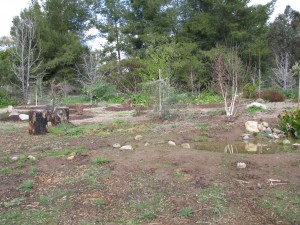
The spot. This spot was left untouched during the creation of the garden because somewhere in the area there had been a fairy ring, which is a ring of mushrooms growing out from a central fungus. I’ve given up hope that its still alive, and this is an ideal spot for watching birds both in the pond and in the trees behind.
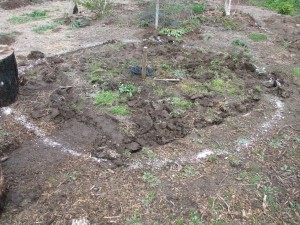
A ten-foot circle. I guessed where the center was, measured roughly five feet (I stepped on the string and held it to my head… I’m 5’3″) and made a ten-foot circle. Why ten? Eight looked too small and twelve too large. I also uncovered the irrigation lines so that I could avoid breaking them (only one casualty).

These logs have to go over there. Old burnt tree stumps had been given to me by Juan, who constructed most of the garden. They’ve been happily growing fungus and providing some habitat as they’ve sat waiting for me to figure out what to do with them. Of course, I wait for the day after a heavy rain when they are good and soaked to move them, and uphill at that! Most of them were old and light enough to roll without too much effort.
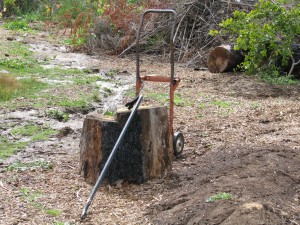
This didn't work. I ended up walking it. Then there was this squat, misshapen devil. It was just oddly shaped enough to not roll, too short and heavy to move with the dolly. Finally I just walked it, bit by bit, curse by curse. I laughed like a madwoman when I put it in place. I’m really glad that I have tolerant neighbors. I often tell my chiropractor about my garden projects. He seems to really like them, and encourages me to keep on hauling flagstone, rolling logs, etc. Hmm.
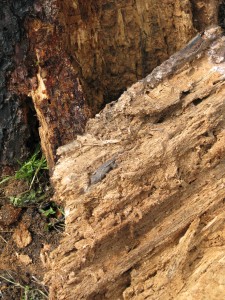
Besides growing interesting fungus, a sleepy lizard was hiding in the log. Of course, right as I position it, some of the back breaks off. There was a sleepy Western fence lizard trying to keep warm.
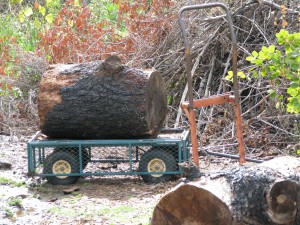
With some interesting swearing, I tipped it onto my wonderful wagon. Just when I thought I’d moved the heaviest, the last one proved to be a monster. It wouldn’t roll. It wouldn’t wheel. I brought out my incredibly handy garden cart, tipped it up, hoisted that guy onto it and off we went! It wasn’t that easy, but I did it. I had a feeling of satisfaction and accomplishment similar to when I took Tai Kwon Do with my kids, and broke a board with my hand and one with my foot. I felt as if I could chop down walls! Anyway, making this ring felt right, and perhaps their acid decomposition will inspire another mushroom ring.

If Stonehenge caught fire. Then I scavenged for old twisty branches and willow. Although I have native willow growing in the streambed, I opted for curly willow for the sides. Not only is it more architecturally pleasing to my eye, it likes full sun and is more drought tolerant than other willows.
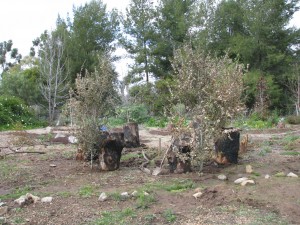
Cut oak trees stuck in for camoflage. Since the willows would just be whips yet, I wanted to kick-start the hide with some camouflage in the form of dead oak trees that hadn’t yet shed their leaves. I stuck them in the mud on either side of the main viewing window. They can be incorporated into the design as the willows grow, or come out easily. Everything is reversible! (I try not to build anything that isn’t).
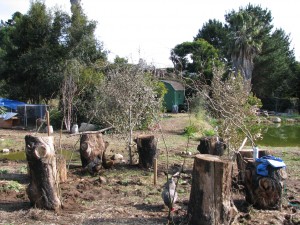
The girls helping me plant the willow withys. I managed to find some long curly willow off of the plants that aren’t even a year old in my garden yet. I want the withys to meet overhead. The ‘windows’ will be over the stumps, except for the main window looking down to the pond. The hens came over to help plant willow by standing on the shovel and in the hole slurping valuable worms. I sure loved the company.
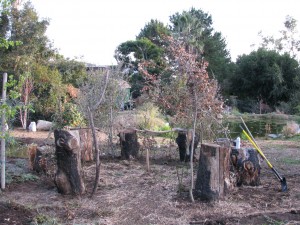
From the entrance. I planted all the willow, but didn’t really finish working on the upper portion before sunset. I really wanted to finish, too, and move on to weeding. Giving the project a little time will help me in finishing it, especially since I’m making it up as I go! I’m not weaving the structure like many willow structures are, but I will be shaping them so that they grow in the right way.

As it looks to ducks. A little anticlimactic, but I’m not done yet! The willow will be growing and filling out with leaves, making the roof canopy all in good time. I bet there are ducks in the pond right now not paying any attention to the hide! 🙂 Tomorrow I might look at it , recoil in horror, and pull everything out. Or not. I’ll let you know.
-
Monday Morning Surfing
Okay, so its Monday morning at ten o’clock and I’m trying to make an unsweetened cup of tea stretch out as an excuse to read funny stuff on the Internet. That’s one of the benefits of living alone… no one but the little taskmaster in my head to crack the whip. Oh, and the bank, but its President’s Day so they should all be closed. Oh, and the animals, but I’ve fed them all, with the exception of Gammera (“Feed the tortoise today, Diane! Remember to feed the tortoise!”). The unsweetened tea is a kind of torture because I usually take it with honey, but I am trying really, really hard to lose that twenty pounds that I thought I had lost for good a couple of years ago, but which found me again. I’m also using the excuse that its the Great Backyard Bird Count weekend to watch the birds swarming to the feeders as I surf. All of this, of course, is an excuse to not go dig bamboo and transplant enormously heavy trees like I did yesterday (that ingrate of a lemon tree poked me in the eye while I was trying to rescue it! I left that sucker partially dug out last night as punishment. See if it learned its lesson by now…). Oh, and its a little cool outside (what a California wimp I am!). I am also feeling the afterguilt (new word?) from having ranted on the blog yesterday. Besides, funny things happen.
For instance last night, while I was watching a couple of Rowen and Martin’s Laugh-In episodes I had waited forever for the library to get in (and can’t renew because its on hold), my fat cat Pippin was zonked out on my favorite chair. Pippin is about 18 pounds. He was a skinny boy that showed up in our yard a couple of years ago and never went away. He sucked down food as if he needed it for emotional support (um… that sounds familiar!). Only one of my other indoor cats will tolerate him. Matthew is a kind-hearted soul. He’s a peace and love kind of cat, at least he’s become that after spending his first year of being in the house hiding behind the bookcase hissing at everyone. Matthew has a deep throaty whirr when he plays wildly with cat toys. Anyway, Matthew, in search of a warm spot (I don’t turn on the house heat), perched on top of the lovely ribbon-embroidery pillow next to Pippin. Somewhere around the point in Laugh In when Miss Greer Garson hit Henry Gibson on the head with an inflated hammer I glanced over to the chair (myself wrapped in several blankets, a robe and two cats), and saw that Matthew had found a warmer place to perch!

A warm, firm mattress that purrs! Pippin is solid, like a beached whale. He protested a little by waving his paw ineffectually (his front legs stick out straight when he lays on his side) and then going back to sleep.

When Pippin moved, Matthew... didn't. So my Internet search started with Facebook, to see if there were any humorous links from my more sophisticated friends (I’m always at least a year behind in finding out the funny stuff. At least three years behind in technology!). Then I checked out Cake Wrecks ( http://cakewrecks.squarespace.com/ ) , which is a hilariously funny blog that posts disaster cakes with wonderful commentary. From there I went to The Bloggess (http://thebloggess.com/2012/02/her-name-is-juanita-juanita-weasel-unless-you-can-think-of-something-better/ ). This blog has pretty ‘mature’ language and topics, but it is laugh-till-you-choke hilarious. From there I went to Know Your Meme (http://knowyourmeme.com/ ). A meme (rhymes with cream… I looked it up) is whatever has viral popularity on the Internet. This site lists current memes, some of which are actually funny, but most of which make you really wonder about the average intelligence of the US Internet audience. Then I followed her link to Pintrest (http://pinterest.com/thebloggess/kick-ass-stuff/) which is a virtual bulletin board where people ‘pin’ interesting things they find on the Internet. Think of it like a workroom pinboard with cut-out jokes and photos hung all over it. I swear, I don’t know how people find the time to do all this Internet stuff and yet conduct normal lives or get enough exercise.
Speaking of exercise, I need to go see if that lemon tree has learned its lesson yet. Oh, and feed the tortoise.
-
Building a Rion Eco-Grow Greenhouse

Greenhouse in a box! Yes, I finally decided upon which greenhouse to buy. It took a year and a lot of research and waiting. I did go back and forth about just throwing some plastic over bowed PVC pipes, but I wanted something that lasted and didn’t look like a piece of junk. Most greenhouses that I wanted were over $1,000, and that was just not going to work. Also, I needed diffused light rather than clear glass or plastic because most of the year here the sun really cooks things. Diffused light will help keep the seedlings from scorching. Since I’m absolutely not a carpenter, and would be assembling this myself, I needed something that went together fairly easily. I found the Rion Eco-Grow, a small greenhouse that snaps together and yet can be enlarged later (http://www.riongreenhousekit.com/rion-ecogrow.php). It isn’t made of aluminum, which can bend easily, and the double plastic ‘windows’ diffused light. It is delivered by standard carrier, not flatbed truck, so the packages are manageable and you aren’t expected to help unload them. It came with a seven-year warrenty and had very good customer reviews on other websites. I not only bought it on sale, but it came with a choice of a gift, and I chose the solar light.

I guess they didn’t fit through the little package door! Last Wednesday I came home to find a couple of friends waiting for me. The boxes were about 60 pounds apiece, but I just levered them onto my garden cart (the best thing I ever bought!) and hauled them down to where the greenhouse was going.

Sorting the parts and leveling the ground took a whole afternoon. Well, it wasn’t easy, putting that thing together. After sorting parts, many of which were not labelled, and then leveling the area where the base would be constructed, it was already an afternoon shot. The next day I started fitting pieces together and trying to figure out the miniscule diagrams. It really is ingeniously thought out.

Pushing together the hardware was fun. Only when it came to fitting glazing on over the roof panels did the very, very bad time happen. I worked for a day and a half on just those glazing; they wouldn’t go in! They recommend soapy water. I had so much soapy water that it was dripping in my shoes. Finally I brought down my electric kettle and poured hot water on some of them. It worked for all except one end, which still isn’t going anywhere. It will have to stay like that.

In pergatory they make you try to assemble the roof parts… forever. When I started work, the ground was pretty dry. Then a puddle was forming in the mud at my feet and I realized that there was a leak in the pipe nearby, so I shut off the outside water until I can fix it. Then I was hurrying to be done before the rain last week, and I didn’t make it. Then, since it was very muddy and I was having so much trouble with the roof I thought I’d back out my riding mower out of the shed and haul the roof inside onto level flooring constructed using waterproof materials Miracote to see if that made any difference. I didn’t get far. I started the mower, tried to reverse, couldn’t clear the entrance way with the mower deck, then realized in only about two minutes time that the exhaust had filled the shed and I was getting sick. I shut off the mower and got out of there. That was the end of that work day, as I recovered my breathing and severe headache in the house. I tasted exhaust in my mouth for a long time afterwards.

Sophie checking on my progress. Then it rained again, and I spent a day running errands. Today I constructed the door and then noticed a spot in the middle that wouldn’t brush off.

What is that mark in the middle….? A spider had worked its way down between the lines of the panel and made a little web! He would certainly die in there, and I’d be watching him do it. So of course I took apart the entire top part of the door, wedged out the panel and blew down the lines, and he popped out the other side. Nothing I can do about the web he left, though.

A spider! Had to get that poor guy out of there I managed to complete everything except for placing the roof on the top. Tomorrow I’ll have help and we’ll do a ‘barn raising’, or, at least, raise the roof, after that, I’ll finally be able to start my project on organic greenhouse production.

All ready to raise the roof! Assembly tips: sort out every piece of equipment. Not all of the pieces are labeled, and some of the panels are only a hair’s difference in size, so measure and mark them all… it will save a lot of re-doing and cursing. Wear gloves. Not so much that the panels will cut you, but they really help save your hands when you are pressing and pressing and pressing and sliding your hands up and down plastic pieces to get them to fit together. If you have issues with your hands and wrists (as I especially do now!) this will be tough on you. Use lots of warm soapy water, and for pieces that either absolutely won’t go together, or for those that did and now need to come apart because they popped out of place, pour boiling water slowly down all pieces concerned. It really does help! Be sure to work on a level surface, even for constructing the roof. Give yourself a break and go do something else for awhile, then come back to the problem. Don’t use a rock to force a piece into place because the plastic will chip off. Ahem.
I’ll post a final photo when I set up shop!
-
Re-Ponding: Changing a lined pond into a natural pond

Draining the pond with a hose syphon. The little upper pond which my daughter and I laboriously created about seven years ago has finally come to the end of its life. Home to dragonflies, mosquito fish, snails, and some interesting black flatworms, and having provided habitat for snakes, birds, mice and frogs, this lined pond has been beautiful and most satisfactory. Having been given the black flexible pond liner sheet, a lot of very heavy flagstone and some stones, we had cut down a juniper, dug out the roots in heavy clay and rocks, shaped the earth into ledges for nursery pots of waterlilies, and leveled the edges. Everything I read about ponds said to put gravel into it, so against my better judgement I did, and immediately regretted it. The gravel prevented me from walking barefoot in the pond, was a danger to the liner, made walking on the ledges in boots very slippery, and has trapped sediment and roots (end of anti-gravel rant). The pond was aerated by a series of very expensive pond pumps, which trickled water down a little waterfall and impacted my electric bill. This pond was a maintenance problem; I would pull out the algae (carefully picking through it to save trapped fish, snails and dragonfly larvae), but the waterlilies got the better of me. I had no idea that they would grow so huge and disgusting underwater. (See my post The Monster in the Pond, March 2, 2010.) Anyway, after the last pump died this summer, and after the enormous success of the two natural, unlined ponds Aquascape created for my permaculture gardens, I decided that I would change this pond into a natural one.
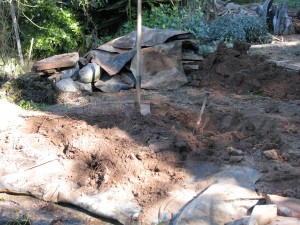
Digging a shallow end for the pond. This area is also the one in which we do our Project FeederWatch bird count for Cornell (http://www.birds.cornell.edu/pfw/), and was our original National Wildlife Foundation Wildlife Habitat (http://www.nwf.org/At-Home.aspx ), which now has extended to our entire property. I wanted a shallow end to the pond with planted waterplants that would clean the water and provide shallow habitat for all the Pacific chorus frogs that come up in late January to breed in the pond. In fact, they’ve been croaking their way up the property already, so now I’m in a rush to get the pond finished for them.

The liner was covered with a mat of plant roots and gravel. Once again I found myself moving large pieces of flagstone and rocks, although I’m seven years older than I was last time, and my back let me know it. Then began the draining of the pond. I tried to start a syphon the way I do to clean my fishtank, by sucking air through a hose and very, very quickly dropping it before I sample the water. I couldn’t get it started. I did get an interesting circular red mark on my lips, which I had to explain that afternoon at my dentist appointment. The difference in elevation between the top and bottom of the hose was not great enough, even though we put together all our hoses and strung them out down the property. I tried to fill the hose with water, but it didn’t work. A phone call to the pond expert, Jacob from Aquascape, made me slap my head with an exclaimed, “Duh!” He recommended attaching the hose to a spigot, sending water through to the pond to fill the hose, then removing the end from the spigot. The water would flow back and the vacuum would start the syphon. Probably everyone in the world knows this, and I knew there was something about attaching a hose that I should do, but couldn’t figure out. Anyway, it worked, but the syphon was a trickle. After many starts and stops, and running back and forth up and down the property, my daughter and I discovered in the morning that the syphon had worked, and almost a quarter of the water had drained. I kept restarting the syphon, until only about a quarter of the water was left. The aroma of the sludgy water infiltrated the house and the yard. I made a fire in the fireplace figuring that for once the smoke was a good thing!

The monster in the pond, revisited. My dear daughter, before returning to college, tackled that monster in the pond. The waterlily was so huge and slippery that she managed to break pieces off but not pull the whole thing out; in fact, she was in danger of being pulled in by it!

Saving water lily chunks to make new plants. Today, with Jacob’s help (actually, he did most of it!), we pulled all the lilies out of the pond. The root systems of the three, which had outgrown their meager nursery containers years ago, just about filled the bottom of the pond. I scraped gravel up with my rubber-gloved hands and then began scooping the remaining water and sludge out with a bucket.

An egret looks hopefully into the sludge. I threw the water onto the plants, and then when the sludge of decayed algae, plant material and soil became thick, I poured it over my bulb beds as a fertilizer. There may be a high concentration of salts in the muck, but the nutrition value should be wonderful. And it makes the ground around my bulbs a lovely black color!

Sludge makes good fertilizer! I almost finished, half-bucketful at a time, hauling water up and out of the pond and onto various areas of the garden, and indeed I meant to finish.

Scooping sludge into a bucket. But with about an inch or more of sludge to go, with yet more gravel to scoop, my body said, “Nope! You’re done!” I also had missed breakfast and had only snacked today, and had been exercising, hiking, planting and weeding for the last few days so I told my self that I had a decent excuse to stop. I took a long hot bath to soak the splashes of yuck off of me, and will continue into the muck and mire tomorrow. Stay tuned!

Our fat cat Pippin, who has nothing to do with this story! -
Becoming Very Behind in my Cleaning

